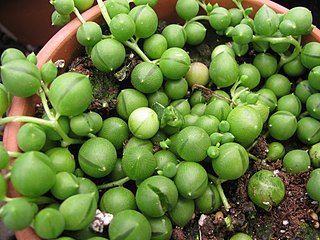
Curio rowleyanus, syn. Senecio rowleyanus, is a flowering plant in the daisy family Asteraceae. It is a creeping, perennial, succulent vine native to the Cape Provinces of South Africa. In its natural environment its stems trail on the ground, rooting where they touch and form dense mats. It often avoids direct sunlight by growing in the shade of other plants and rocks. It is commonly known as string-of-pearls or string-of-beads.
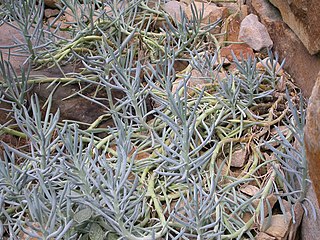
Curio ficoides, syn. Senecio ficoides, also known as skyscraper Senecio and Mount Everest Senecio, is a species of succulent plant, in the genus Curio (Asteraceae), indigenous to South Africa.

Curio archeri, syn. Senecio toxotis is a species of succulent plant in the family Asteraceaethat is indigenous to the south-western Cape, South Africa.
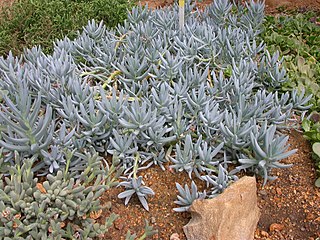
Curio repens is a species of succulent groundcover plant in the genus Curio, in the Asteraceae family. Visually-similar to the ice plants of Mesembryanthemum, or “mesembs”, C. repens is typically found growing in and among rocky crevices and exposed ledges on dry, rubble-strewn sandstone slopes, where drainage is swift and sun exposure and airflow is high. Commonly named blue chalksticks, blue chalk fingers or simply “blue iceplant”, it is frequently used in Mediterranean climate landscaping and as an ornamental plant.

In botany, succulent plants, also known as succulents, are plants with parts that are thickened, fleshy, and engorged, usually to retain water in arid climates or soil conditions. The word succulent comes from the Latin word sucus, meaning "juice" or "sap".
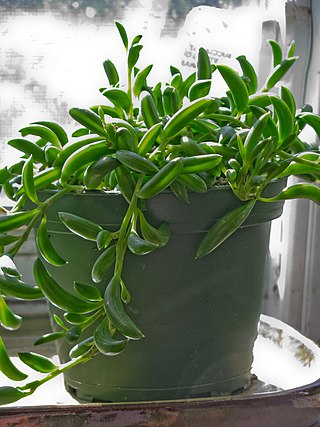
Curio radicans, syn. Senecio radicans, is a succulent houseplant that is native to Southern Africa. A member of the family Asteraceae, the asters, this species is closely related to the common string of pearls and Curio hallianus. It has multiple tendrils of glossy, banana-shaped foliage. It is commonly known as string of bananas or fishhook senecio.

Curio × peregrinus, also known as dolphin necklace, flying dolphins, string of dolphins, dolphin plant or Senecio hippogriff, is a succulent nothospecies of Curio in the family Asteraceae. It is often called, incorrectly, Senecio peregrinus, but that name was previously given, by Grisebach in 1879, to a different species from South America. The name Curio × peregrinus was published in 1999, based on the earlier name Kleinia peregrina; however, this name was not validly published. The plant is a hybrid between Curio rowleyanus and Curio articulatus.

Curio is a genus of flowering plant in the family Asteraceae. Plants in the genus are evergreen succulents with long, striated leaves and discoid flower heads lacking ray florets.
Curio corymbifer, synonyms including Senecio corymbifer and Senecio sarcoides, is a species of succulent flowering plant in the aster family Asteraceae, indigenous to the Cape Provinces of South Africa, Namibia and Swaziland.
Senecio cotyledonis ("Stinkbos") is a species of succulent flowering plant in the aster family, native to the Western Cape and Northern Cape of South Africa and to Namibia.
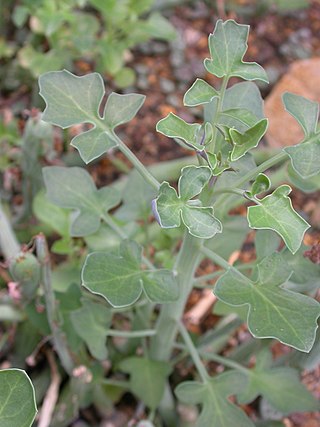
Curio articulatus, syn. Senecio articulatus, which is also known as candle plant, pickle plant and hot dog cactus, is a deciduous succulent plant that is native to South Africa.

Curio herreanus, syn. Senecio herreanus, which is also known as string of watermelons, string of beads, gooseberry plant and string of raindrops, is a flowering succulent plant in the daisy family Asteraceae that is native to Namibia. It is grown as an ornamental plant and is very similar in appearance to 'string of pearls', where the names may be conflated.
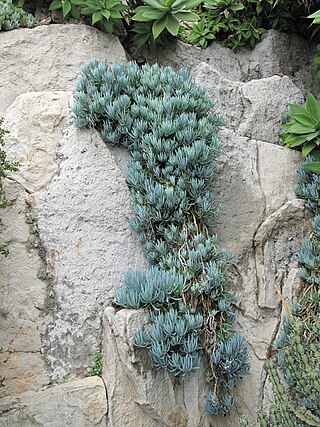
Curio talinoides, syn. Senecio mandraliscae, also known as blue straws, blue chalksticks, dassieharpuis, or narrow-leaf chalk sticks, is a succulent plant of the family Asteraceae that is native to South Africa. The origin of this plant is dubious and it may be a hybrid.

Curio crassulifolius, also known as blue fingers, is a succulent in the family Asteraceae that is native to South Africa.
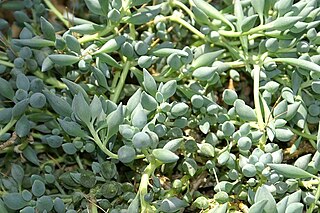
Curio citriformis, syn. Senecio citriformisis, also known as string of tears, is a trailing succulent plant in the family Asteraceae native to South Africa that grows in rocky outcrops in clay soils.

Curio acaulis is a succulent plant of the family Asteraceae that is native to Namibia and the Cape Provinces of South Africa.

Curio hallianus, syn. Senecio hallianus, is a creeping succulent plant in the daisy family Asteraceae that is native to the Cape Provinces of South Africa. It is also known as chain of blue beans or string of beans.
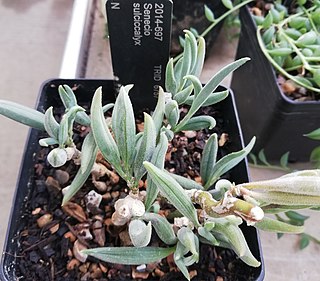
Curio sulcicalyx is a small succulent plant in the family Asteraceae that is native to Namibia and the Cape Provinces of South Africa.

Curio 'Trident Blue', known commonly as Senecio 'Trident Blue', Trident Blue Chalk and Kleinia 'Trident Blue', is a spear-shaped succulent plant that is a hybrid of Curio repens and Curio talinoides.

Gordon Douglas Rowley (1921–2019) was a British botanist and writer specialising in cacti and succulents.


















